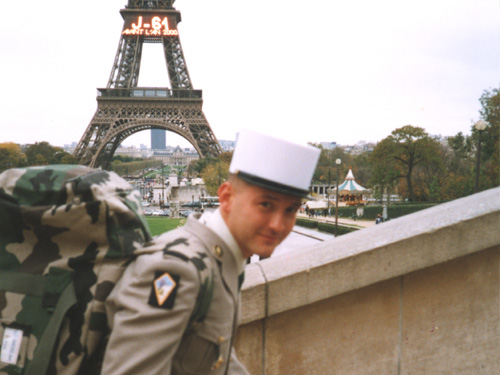Gallery
-
Jaime Salazar
Pictured here in tenue de combat and the renowned Foreign Legion headdress, the képi blanc (white cap). Dressed in combat fatigues, legionnaires normally wear the green beret. Velcro nametags (upper right breast) are removed when in public. Strapped across the chest is the 5.56mm FA-MAS assault rifle. Known as le clarion (trumpet), the bullpup configuration weighs 3.36 kg and can use NATO cartridges. Its size and weight make it ideal for bush conflicts.
The Long March
No other army emphasizes the old-fashioned tradition of the long march more than the Foreign Legion, true to its tradition of traversing the Sahara by foot. The Foreign Legion has always been a cash-strapped army in which motorized transport has been scarce. Under any weather conditions and with any heavy load, dropping out is not an option. From the days of Moroccan pacification, when exhausted legionnaires were left by the wayside to perish in the hands of local tribesmen, the common Legion maxim became “March or Die.”
Soldiers for France
Though a legionnaire, by extension, fights for France, legionnaires take an oath only to serve the Foreign Legion. Violence is commonplace in the Legion, especially during basic training (note the blackened right eye). What makes the Foreign Legion’s tenue de parade (dress uniform) unique is the blue cummerbund, red/green epaulettes, and the képi blanc. Sahara based legionnaires were issued khaki covers to be worn over their black caps. With enough time and sun, the covers became bleached white, the sign of an old experienced hand. After WWI, the “white” képi became official. The Foreign Legion has always been the last unit to arrogantly parade down Paris' Champs Elysées every year on Bastille Day.
Feet
The qualifying march for basic training completion is the beastly 7-day raidmarch through the Pyrenees. After 4 months of conditioning, legionnaires are habituated to march from sunrise to sundown for days on end. Nearing the final day, feet become a major concern. A common Legion adage is that one never becomes a legionnaire without first filling his boots with his own blood.
Back of the Truck
Back of the truck bonding with legionnaires who may not have wanted to have their picture taken. Dogs howl when the Legion is on the march. Any village farmer, butcher, or shopkeeper is likely to be shocked to see a band of solders passing, cursing in Polish, Russian, Spanish, English, and thick broken French.
Camarades
Salazar with two other Polish comrades in summer tenue de sortie (walking-out uniform). After months of basic training, legionnaires are allowed one afternoon of leave in the village of Castelnaudary, where they are generally free to do as they wish, drinking to excess included. Local authorities are notified, and the Police Militaire monitor the rail station and taxi terminals for potential deserters.
Sport
Salazar in typical tenue de sport. The Legion puts a great emphasis on physical fitness, and sport is religion. Runs are rarely shorter than 15 kilometers. Though most legionnaires are scrawny by American military standards, they are capable of amazing feats of stamina. The Foreign Legion is also one of the few armies with professional athletes within its ranks. It even boasts of it’s own cross country team with several Olympic runners.
Pic Peric
The Foreign Legion is renowned for overcoming any obstacle and foe, in this case, mounting Pic Peric in the Pyrenees on a single day’s march. The look on the face says it all. In the nearby village of Mount Louis is the commando school, where live fish are caught and eaten like chocolate bars.
Eiffel Tower
Since its inception as a throwaway army for fighting in France’s overseas colonies, the Foreign Legion has had a love-hate relationship with its adoptive homeland. After the failed Algerian putsch in 1962, when the Legion itself was planning to para-drop over Paris to invade, De Gaulle considered disbanding it altogether. But after downsizing it to 8,000 men, stripping it of all heavy weaponry, the Legion was spared, packed up and re-headquartered to metropolitan France.
Valloire
From its days fighting the Nazis in Norway, the Foreign Legion has proved itself a formidable force capable of fighting not only in the desert of North Africa, but in the jungles of Guyanne, and the Alps of Europe. The 2e REG is the Foreign Legion’s mountain regiment. On a yearly basis, legionnaires take both a summer and winter mountaineering course in the mountain village of Valloire.
Time Off
Contrary to popular myth, legionnaires do get time off, usually in the form of a 36-hour weekend, when they are free to travel within the confines of France as they wish. Only after several years of service, and with the permission of the regiment’s colonel, are legionnaires allowed to own a vehicle, open a bank account, or revert to one’s previous name and identity. Legionnaires are allowed to live off of base and marry after their first five-year contract. Contact with the outside world is precious.








